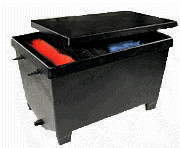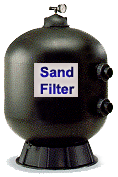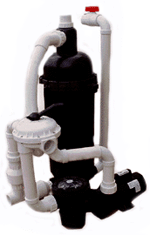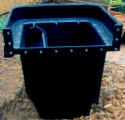 |
|

|
 One of the most important aspects of maintaining a
healthy, attractive backyard pond is filtration. Fish and decomposing
plant material are constantly adding nutrients and chemical waste products
into the water. If these build up in the water, it can cause problems for
the fish and will contribute to the algae problem. Filters help bring the
pond back into natural balance which will tend to keep the fish, plants
and you happy. One of the most important aspects of maintaining a
healthy, attractive backyard pond is filtration. Fish and decomposing
plant material are constantly adding nutrients and chemical waste products
into the water. If these build up in the water, it can cause problems for
the fish and will contribute to the algae problem. Filters help bring the
pond back into natural balance which will tend to keep the fish, plants
and you happy.
About the only exception to the rule is a small pond with
only plants or one or two fish. Often such a small volume of water can be
kept in a natural balance without external filtration. However, for most
backyard ponds, some way of removing excessive nutrients and solids from
the water.
|
 Physical Filters -
The idea behind a physical filter is to trap particles as they move Physical Filters -
The idea behind a physical filter is to trap particles as they move
 through the pond system. Screens and layers of filter fabric material provide a level of filtration
for the larger particles in the water.
They may become clogged over time so they need periodic cleaning to remain
effective. Skimmers are often used in a filtration system to catch the
larger items such as leaves from nearby trees or, heaven forbid, dead
fish. through the pond system. Screens and layers of filter fabric material provide a level of filtration
for the larger particles in the water.
They may become clogged over time so they need periodic cleaning to remain
effective. Skimmers are often used in a filtration system to catch the
larger items such as leaves from nearby trees or, heaven forbid, dead
fish.
|
  Biological Filters -
Biological filters use nature
to remove nutrients and harmful byproducts from the water in the pond.
Having success with a biological filter is similar to having success with
a compost pile. In both cases, the goal is to provide the proper
conditions so that bacteria can survive and multiply. It is these
microscopic critters that eat the nutrients and byproducts and turn them
into more inert substances. Biological Filters -
Biological filters use nature
to remove nutrients and harmful byproducts from the water in the pond.
Having success with a biological filter is similar to having success with
a compost pile. In both cases, the goal is to provide the proper
conditions so that bacteria can survive and multiply. It is these
microscopic critters that eat the nutrients and byproducts and turn them
into more inert substances.  When they take up the extra nutrients in the
water, they deprive the algae of needed fertilization. When they take up the extra nutrients in the
water, they deprive the algae of needed fertilization.
For
the bacteria to thrive, they need some type of substrate to anchor onto
while the water flows past. This may range from sand to nylon bags filled
with volcanic stones. Whatever the substrate, it needs periodic cleaning
but you do not want to bother it more than once a year or so. Each time
the substrate is flushed with a blast of clean water, the bacteria will
also be removed. Once they are placed back into the pond system, it will
take some time for the population of bacteria to rebuild itself. Thus, it
will also take time for the filter system to become fully functioning
again.
|
 Bottom Filters -
Ponds that have small stones covering the bottom present other options
and problems. In an aquarium, bottom filters are used to draw waste
products down in the stones where they are acted upon by the bacteria.
The problem with using a similar system in a backyard pond is that they
are much more difficult to clean out. The pores between the stones
become clogged requiring the removal of all the stones to allow for
adequate cleaning. This is a lot of work! Bottom Filters -
Ponds that have small stones covering the bottom present other options
and problems. In an aquarium, bottom filters are used to draw waste
products down in the stones where they are acted upon by the bacteria.
The problem with using a similar system in a backyard pond is that they
are much more difficult to clean out. The pores between the stones
become clogged requiring the removal of all the stones to allow for
adequate cleaning. This is a lot of work!
|
  Ultraviolet
Filters - Another
approach to algae control in the backyard pond is to expose the algae to
ultraviolet light. This is supposed to kill the individual algae plants
to keep the populations low. Ultraviolet
Filters - Another
approach to algae control in the backyard pond is to expose the algae to
ultraviolet light. This is supposed to kill the individual algae plants
to keep the populations low.
The water is piped through a unit similar
to the one displayed above. It is connected to an electrical outlet for
power to run the ultraviolet lights within the tubes. As the algae pass
by the light, they are killed.
|
|
 Big Time Koi Ponds Big Time Koi Ponds
|
|
 If
your goal is to raise champion quality koi, your filtration demands will
generally be greater than for the average backyard pond. Often, you will
be growing a larger number of fish of larger sizes that produce greater
amounts of waste. If
your goal is to raise champion quality koi, your filtration demands will
generally be greater than for the average backyard pond. Often, you will
be growing a larger number of fish of larger sizes that produce greater
amounts of waste.
To keep the ponds clear and healthy, will also require
more elaborate filters that may require more frequent maintenance. Large
filters located outside the pond may be used to filter out extremely fine
particles and to remove high levels of nutrients and mineral waste
products.
If this is your situation, you may want to check with the
Koi societies and organizations for advice on recommended filtration
systems.
|
 |
 |
 |
|
|
-
When installing the biofilter, be sure that the top is
level before filling in around it. If it is not level, water will flow
in an irregular pattern and give a "lopsided" appearance to
your waterfall.
|
 |
 |
|
|
|
|